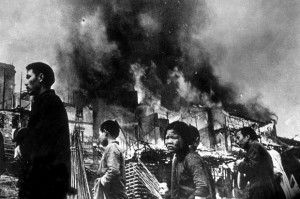 Much of literary history leaves me with an overwhelming sense of “Who cares?” The minutiae of specific dates, lists of first publications and endless variants, it’s generally very tedious. Throughout the non-fiction Shakespeare in Company, however, Bart Van Es employs that scholarship to develop a compelling study of the bard and his working life. The basic idea is that Shakespeare was brilliant, but what enabled him to realize his potential and become a revolutionary literary figure were his working conditions and the company of people he kept around him. This thesis is well supported and fascinating, and the book is a great look at a genius and the context that supported and shaped him in his artistry.
Much of literary history leaves me with an overwhelming sense of “Who cares?” The minutiae of specific dates, lists of first publications and endless variants, it’s generally very tedious. Throughout the non-fiction Shakespeare in Company, however, Bart Van Es employs that scholarship to develop a compelling study of the bard and his working life. The basic idea is that Shakespeare was brilliant, but what enabled him to realize his potential and become a revolutionary literary figure were his working conditions and the company of people he kept around him. This thesis is well supported and fascinating, and the book is a great look at a genius and the context that supported and shaped him in his artistry.
Starting Out
Van Es divides Shakespeare’s career into four phases: An early phase before 1594, a company phase before 1599, a playhouse phase before 1608, and a late phase before his retirement in 1614. Each is addressed by a section of this book.
Shakespeare appears in the literary record in 1592 an already apparently well known and well regarded poet and playwright. His education and career up to that point are murky, but Van Es makes a solid case that they weren’t particularly unique among the poets and playwrights of the time. Shakespeare was actually solidly part of a whole class of writers engendered by recent changes and improvements in the English education system, particularly the grammar schools. His early known writings also echo those of many other authors in style and content.
Importantly, at this point the trajectory of Shakespeare’s career follows those of many others. Examples include his search for literary patronage and carefully stewarded publication of his poems, neither of which he would pursue after this phase. As a playwright he also wrote under common conditions and constraints, very similar to modern day Hollywood scriptwriters: Authors retained no control of their works, received no ongoing recompense from them once purchased, weren’t particularly involved in their production, and had little or no a priori idea of the casting. Scripts were also often the product of many people, both working collaboratively and in successive edits and rewrites. Among all this Shakespeare stood out in quality but not in kind, he fit very well into a mold and trajectory common to poet-playwrights of the time.
Company Man
In 1594 though Shakespeare bought in as a founding co-owner of The Lord Chamberlain’s Men, the acting company with which he would come to be inextricably associated. From that point, Van Es argues believably, he became literally unique in his position and that in turn enabled his output to be unique. Essentially no other playwright of the period was a sustained part owner in such a company. That afforded Shakespeare many things, notably authorial control over his works, continuing income from their production, and less time pressure. As one example, that control and security seemingly enabled a less misogynistic tone in his plays of this period compared to those of his peers and the works Shakespeare himself had produced earlier while writing enmeshed in that culture.
More dramatically, the company meant Shakespeare was working with and writing for the same group of players, his co-owners, over time. To an unprecedented degree he had specific ideas about players to fill certain roles, and the ability to execute that in production. That group was also tight knit and developed a long history and complex personal relationships. All of that showed up in Shakespeare’s plays of this period. Previously he and all other playwrights had produced essentially flat characters. Even the lead would have good speeches but not much depth, with binary transitions between emotions and motivations, few interpersonal connections to other characters, and random inconsistencies throughout a play. Those traits all came about due to the necessarily plug and play nature of the plays, required by a creation process involving many different authors and no real linkage between writing and production. Secure within the Lord Chamberlain’s Men though, Shakespeare had the control, resources, and examples to focus on interpersonal relationships among a relatively small group, and his great plays from this period demonstrate that amply.
The Globe
Shakespeare’s material situation again evolved and improved in 1599, with again a consequent change in his work. At that point he and others of The Lord Chamberlain’s Men founded The Globe Theater. This was another unprecedented move, the players owning the playhouse, and gave Shakespeare even more security and control. Notably, that commitment to the Globe theater also committed Shakespeare to a particular audience segment and worldview, which shaped how he incorporated and responded to changing tastes and rival companies, emerging for the first time after a period of relatively limited competition.
The Globe also changed the nature of the company. The group of more or less equal partners became smaller and closer. This shows up qualitatively and even quantitatively in Shakespeare’s writing. Whereas major parts previously had a fairly even distribution of lines, the plays from this period lavish much more speaking time on specific lead roles. In particular, Shakespeare came to work closely with and write his great dramatic pieces from this era specifically for Richard Burbage, the leading dramatic actor of that era. The latter’s unique talents on the stage enabled Shakespeare to develop an interior world and gradually changing characters unsupportable by other actors of the time. In particular, without that unique partnership of great actor and great writer working closely over years, Van Es essentially argues that a work such as Hamlet, especially designed for Burbage and his opus as well as Shakespeare’s, would have been unimaginable to conceive, let alone impossible to achieve.
Tempest
Finally, Shakespeare’s working circumstances again changed as The Lord Chamberlain’s Men, now the King’s Men, grew and moved on. Van Es argues well that the shift in writing style and thematic matter in Shakespeare’s later plays was not primarily driven by the company’s patronage by the King, nor the physical architecture of their new, indoor winter venue of the Blackfriars theater, as many theories hold. Similarly, Van Es argues that it was not because Shakespeare had begun retirement and become more reclusive. Indeed, Van Es shows that in some ways the opposite was true: Shakespeare was more financially invested in theatrical efforts than ever before, and he was actually much more collaborative and social in a literary sense than he had been since the start of his career.
However, what had changed was that the group was no longer small and close. The company had increasing numbers of hired non-owner players, and the partnership less equal. Van Es homes this change in 1608, with the company beginning operation of the Blackfriars and making a dramatic shift in the partnership structure of the group. Similarly, by then many members of the group had themselves ceased playing, likely including Shakespeare himself.
With Shakespeare less involved in the daily production of plays, and the players’ group less intimate, that social space was filled by other poets. Their renewed presence in Shakespeare’s life in turn engaged him in the literary scene in a way he had not been for fifteen years. The staunch individuality in style, content, and form that he had maintained since the forming of The Lord Chamberlain’s Men shifted back again toward the more literary and classical approach of his poet peers. This in turn lead to a minimization of interpersonal relationships, and increased focus on spectacle and introspective examinations on art itself.
Theater
In addition to that main thread, Van Es’ text provides a lot of insight into theater of the time, both its operations and its deeper meanings and connotations. For example, the book has a great sidenote discussion about the presentation of Robert Armin as the fool in King Lear. The fool is referenced several times well before actually appearing on stage, and Van Es notes the extra dramatic tension the audience would have experienced, knowing that he was lurking just backstage, particularly as the audience would know full well it would be the great, well established fool Armin. That kind of tension just isn’t the same in a film.
Writing
As a minor nitpick, Shakespeare in Company is a bit annoying to read at times as it can’t really settle on whether or not footnotes are just for references or also include meaningful tangential information. The early chapters in particular with much historical referencing suffer from this. However, it is worth soldiering through as it becomes more readable, particularly if you start largely ignoring the footnotes, and insights and arguments of the main thesis are well worthwhile.
This is perhaps obvious, but the book is also almost certainly not worth reading without some knowledge of at least Shakespeare’s major plays. In particular, the text focuses on Titus Andronicus, The Taming of the Shrew, the second tetralogy, Hamlet, Othello, and King Lear. There’s too much analysis and discussion reliant on referencing the characters and plot arcs of those to make it readily decipherable without basic familiarity. With that background though you can gain a fair bit of insight into not just Shakespeare, but those plays themselves.
Conclusion
All in all, Van Es’ thesis is very believable and argued in depth. I found it a fascinating study of how a team of remarkable individuals shape and enable each other, in this case producing one of the truly singularly accomplished people of all time and some of the greatest works of art. Shakespeare in Company is well worth reading for anyone remotely interested in these plays and more generally in the intermingling of genius and context. A good taste of the book can be found in the Times Literary Supplement’s review, which summarizes at length how some of the various actors and writers shaped Shakespeare’s works, particularly discussing the shift in company membership from the clown William Kempe to the fool Robert Armin.









